Mattingly J.D., Heiser W.H., Pratt D.T. Aircraft Engine Design
Подождите немного. Документ загружается.


Appendix M
Example Material Properties
Our purpose here is to provide the basis for representative structural properties
of materials typically found in aircraft engines for use in component design cal-
culations of Sec. 8.2.3. The amount of information that might be displayed can
truly be called bewildering for a number of reasons. To begin with, the material
for each separate engine part is carefully selected, taking into account its usage,
environment, and required durability. Furthermore, for each part there are many
competing materials that have similar capabilities, but different compositions,
processing methods, and brand names. Finally, many properties of a candidate
material must be known before a confident design can be contemplated, such as
allowable tensile and compressive strengths, cyclic strength, creep rates, oxidation,
erosion, and corrosion rates, fracture toughness, crack propagation rate, ductility,
allowable deformation, hardness, modulus of elasticity, thermal conductivity, ther-
mal growth coefficient, and Poisson's ratio (all as a function of time, temperature,
and heat treatment). The permutations are endless.
To cope with this in a textbook, drastic reductions must be made. They are
achieved by only including materials for critical parts (see Sec. 8.2.3), giving
only one example for each generic application, and, most importantly, concen-
trating mainly upon allowable creep strength as required by the considerations of
Sec. 8.2.3.
Although not used directly in the design examples, special attention is drawn
here to the so-called fatigue or cyclic strength of these typical engine materi-
als. This has been done because the life of engine parts is often consumed by
fatigue--or at least by a combination of steady-state and cyclic stress. Exactly
how this combination is accounted for in practice is usually a proprietary
matter. The general nature of the jet engine is such that the major source of cyclic
stress at the "cold end" (i.e., fan and compressor) is vibratory excitation, it and
therefore occurs at about 1000 cycle/s, whereas at the "hot end" (i.e., burner and
turbines) it is a result of pressure and temperature transients and therefore occurs
at about 1 cycle/h. Vibratory and pressure or thermal fatigue are therefore often
referred to as high-cycle and low-cycle fatigue, respectively. The example mate-
rial properties gathered here contain fatigue strength data appropriate to the usual
application of each material, while illustrating the perplexing behavior of this
characteristic.
The information assembled here has been abstracted from the Battelle Memo-
rial Institute's
Aerospace Structural Metals Handbook. 1 The
seven examples are
presented more or less as in their usual order of appearance from the inlet to the
exit of the engine.
623
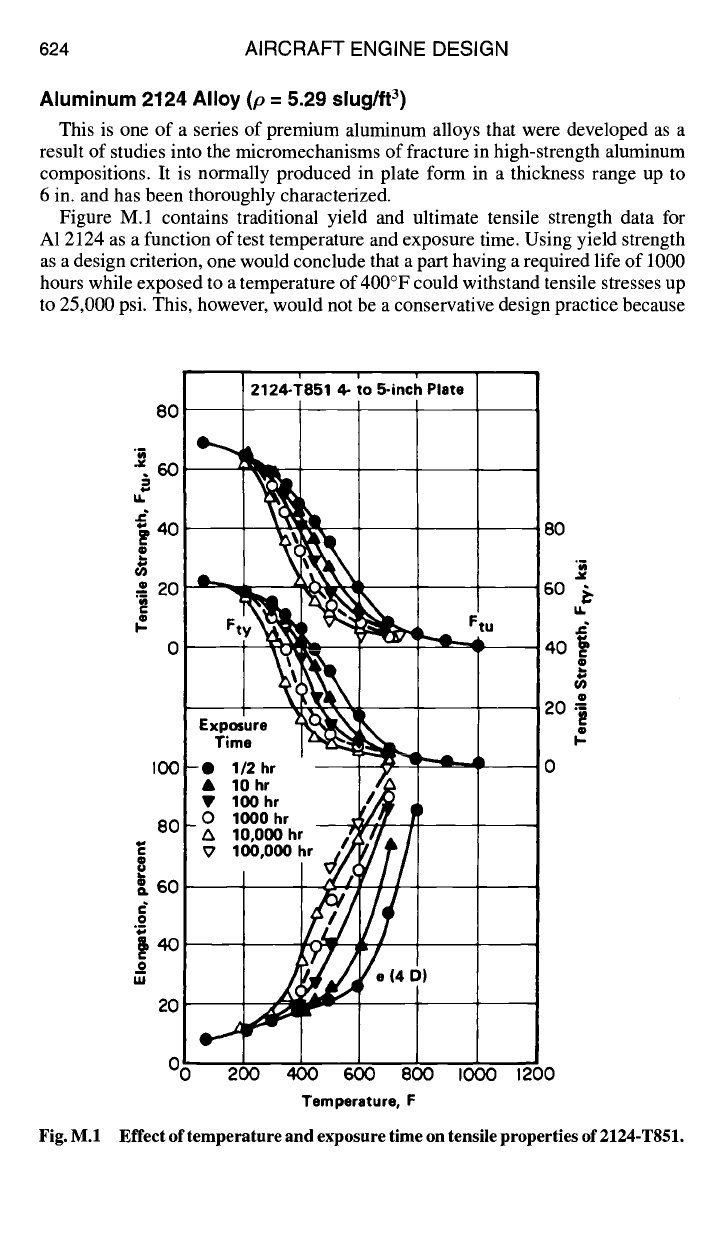
624
AIRCRAFT ENGINE DESIGN
Aluminum 2124 Alloy (p = 5.29 slug/ft 3)
This is one of a series of premium aluminum alloys that were developed as a
result of studies into the micromechanisms of fracture in high-strength aluminum
compositions. It is normally produced in plate form in a thickness range up to
6 in. and has been thoroughly characterized.
Figure M.1 contains traditional yield and ultimate tensile strength data for
A1 2124 as a function of test temperature and exposure time. Using yield strength
as a design criterion, one would conclude that a part having a required life of 1000
hours while exposed to a temperature of 400°F could withstand tensile stresses up
to 25,000 psi. This, however, would not be a conservative design practice because
Fig. M.1
i 1
2124-1L851 4- to 5-inch Plate
80
. 80 r
~ 60
80
60
i1
o
0
2O ~
C
0
I,-
--0
O0 200 400 600 800 I000 1200
Temperature, F
Effect of temperature and exposure time on tensile properties of 2124-T851.
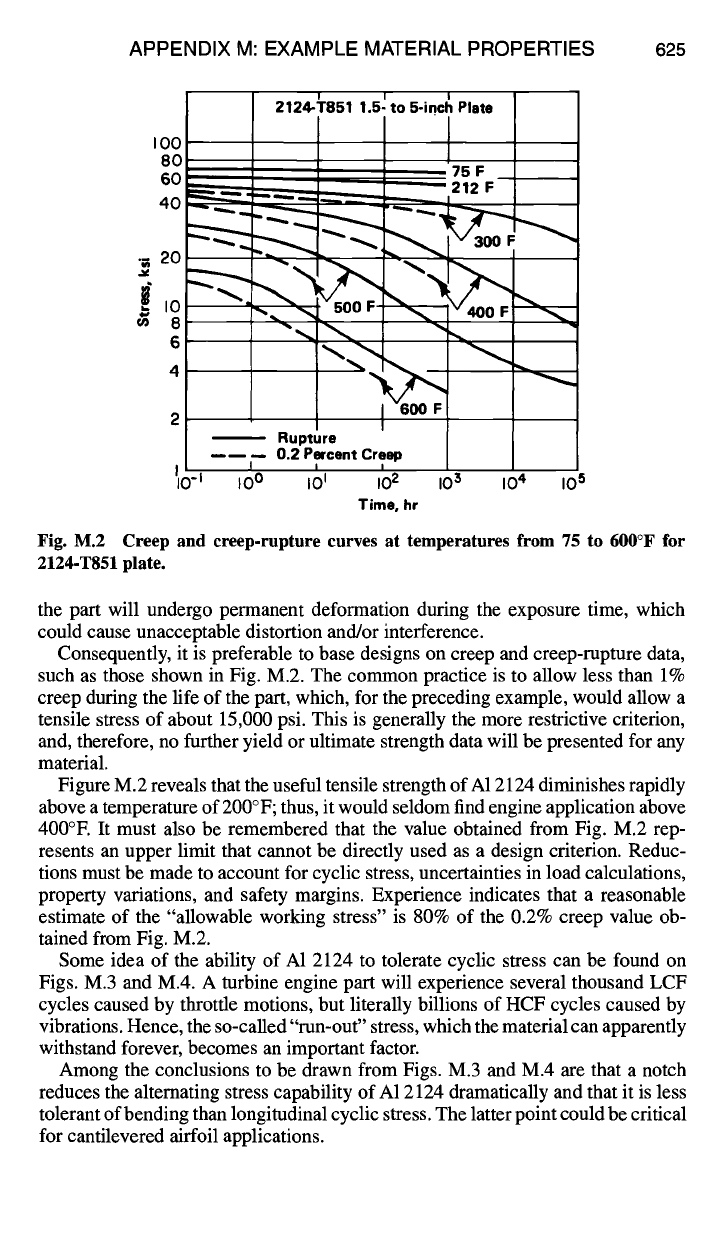
APPENDIX M: EXAMPLE MATERIAL PROPERTIES 625
I I I
2124-T851 1.5- to 5-inch Plate
,oo
- I I t
80 75 F
60--
40 ~ -- -- 212 F
4
~
2
Rupture
I 0.2 Percent Creep
I
lO-I i0 o I01 102 103 104 i0 {i
Time,
hr
Fig. M.2 Creep and creep-rupture curves at temperatures from 75 to 600°F for
2124-T851 plate.
the part will undergo permanent deformation during the exposure time, which
could cause unacceptable distortion and/or interference.
Consequently, it is preferable to base designs on creep and creep-rupture data,
such as those shown in Fig. M.2. The common practice is to allow less than 1%
creep during the life of the part, which, for the preceding example, would allow a
tensile stress of about 15,000 psi. This is generally the more restrictive criterion,
and, therefore, no further yield or ultimate strength data will be presented for any
material.
Figure M.2 reveals that the useful tensile strength of A12124 diminishes rapidly
above a temperature of 200°F; thus, it would seldom find engine application above
400°F. It must also be remembered that the value obtained from Fig. M.2 rep-
resents an upper limit that cannot be directly used as a design criterion. Reduc-
tions must be made to account for cyclic stress, uncertainties in load calculations,
property variations, and safety margins. Experience indicates that a reasonable
estimate of the "allowable working stress" is 80% of the 0.2% creep value ob-
tained from Fig. M.2.
Some idea of the ability of A1 2124 to tolerate cyclic stress can be found on
Figs. M.3 and M.4. A turbine engine part will experience several thousand LCF
cycles caused by throttle motions, but literally billions of HCF cycles caused by
vibrations. Hence, the so-called "run-out" stress, which the material can apparently
withstand forever, becomes an important factor.
Among the conclusions to be drawn from Figs. M.3 and M.4 are that a notch
reduces the alternating stress capability of A12124 dramatically and that it is less
tolerant of bending than longitudinal cyclic stress. The latter point could be critical
for cantilevered airfoil applications.
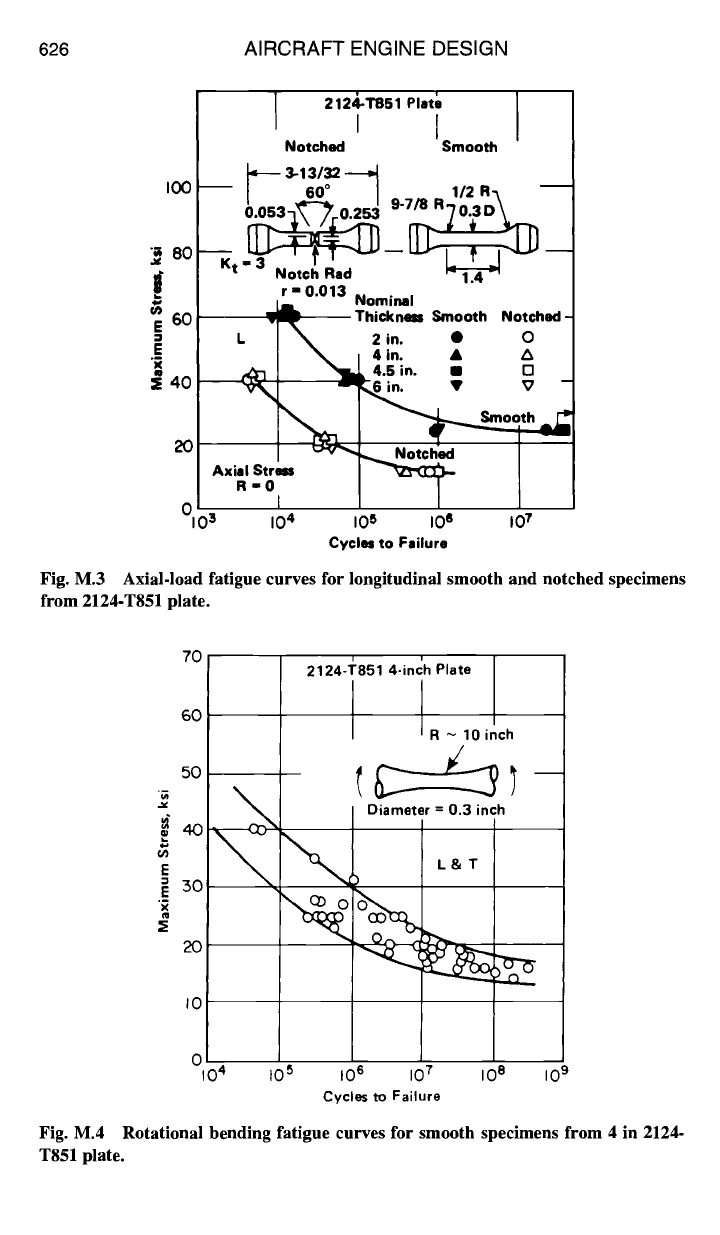
626 AIRCRAFT ENGINE DESIGN
100 n
"; 80--
J¢
!
E 60
L
I 2124-T851 Plate
i [
Notched Smooth
60 ° | . 1/2 R
K,- 3 .o,o~ .a.
r - 0.013
Im Nominal
.~ Thickness Smooth Notched-
= • \ 2 in. • O
._E I ~ 4 i,,. • z~
x ~tl ] "~. 4.5 in. • r-I
40
.
-
20 I '-."v~ ~Notch.ed
Axial Stress
R-0 I
0103 10 4 10 5 106 10 7
Cycle= to Failure
Fig. M.3 Axial-load fatigue curves for longitudinal smooth and notched specimens
from 2124-T851 plate.
70
60
50
i
2124-T851 4-inch Plate
R ~ 10 inch
¢,3
E
~= so
x
20
10
Diameter = 0.3 inch
L&T
b
0104 t0 5 I0 6 l0 T 108 109
Cycles to Failure
Fig. M.4
Rotational bending
fatigue curves
for smooth specimens from 4 in
2124-
T851 plate.
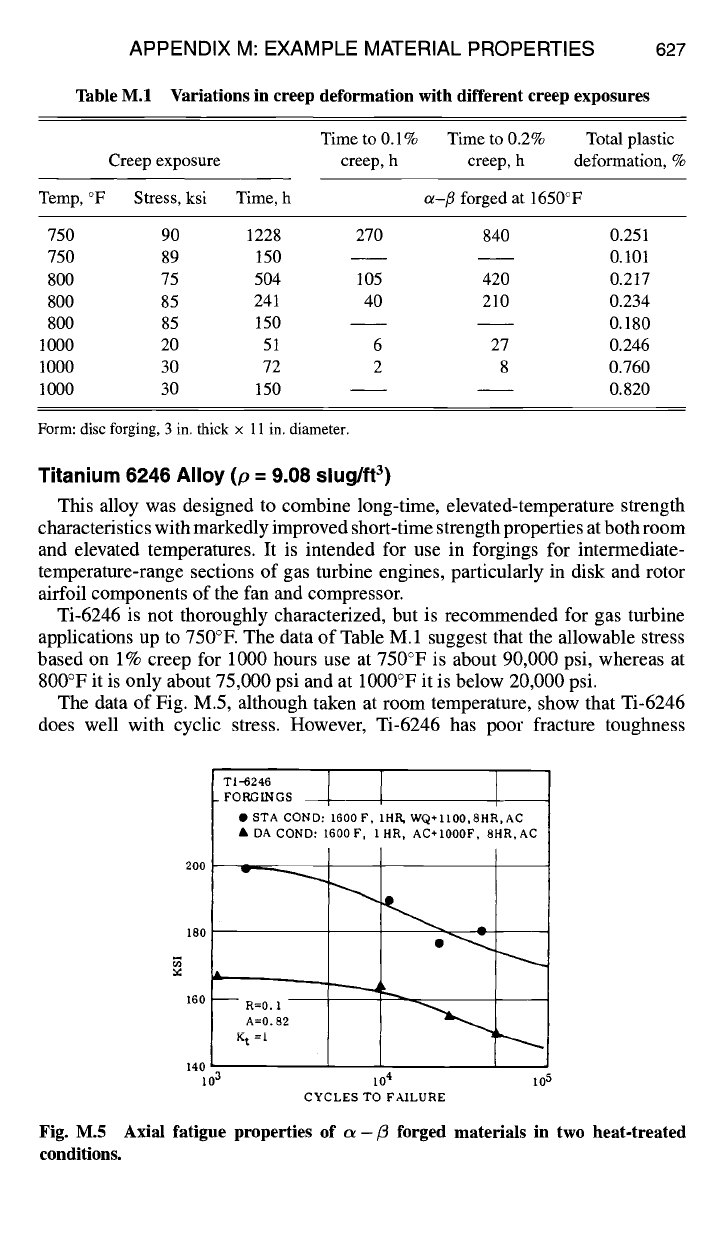
APPENDIX M: EXAMPLE MATERIAL PROPERTIES 627
Table M.1 Variations in creep deformation with different creep exposures
Time to 0.1% Time to 0.2% Total plastic
Creep exposure creep, h creep, h deformation, %
Temp, °F Stress, ksi Time, h ee-fl forged at 1650°F
750 90 1228 270 840 0.251
750 89 150 0.101
800 75 504 105 420 0.217
800 85 241 40 210 0.234
800 85 150 0.180
1000 20 51 6 27 0.246
1000 30 72 2 8 0.760
1000 30 150 0.820
Form: disc forging, 3 in. thick x 11 in. diameter.
Titanium 6246 Alloy (p = 9.08 slug/ft 3)
This alloy was designed to combine long-time, elevated-temperature strength
characteristics with markedly improved short-time strength properties at both room
and elevated temperatures. It is intended for use in forgings for intermediate-
temperature-range sections of gas turbine engines, particularly in disk and rotor
airfoil components of the fan and compressor.
Ti-6246 is not thoroughly characterized, but is recommended for gas turbine
applications up to 750°E The data of Table M.1 suggest that the allowable stress
based on 1% creep for 1000 hours use at 750°F is about 90,000 psi, whereas at
800°F it is only about 75,000 psi and at 1000°F it is below 20,000 psi.
The data of Fig. M.5, although taken at room temperature, show that Ti-6246
does well with cyclic stress. However, Ti-6246 has poor fracture toughness
200
180
160
140
TI-6246
_ FORGINGS --
• STA COND: 1600 F, IHl~ WQ+II00,8HR,AC
• DA COND: 1600F, I HR, AC+I000F, 8HR, AC
R=0.1
A=0.82
K t =1
103 104 105
CYCLES TO FAILURE
Fig. M.5 Axial fatigue properties of c~-/~ forged materials in two heat-treated
conditions.

628 AIRCRAFT ENGINE DESIGN
100
10
INCONE L' 601 I 1
SOLUTION
TREATED AT
2100F --
1000F
/
~1200F
~1300F
1400F
1600F
1600F
1800F
~ 2000F
0.1
0. 0001 0. 001 0.01 0.1 1.
MINIMUM CREEP RATE - PERCENT PER HOUR
Fig. M.6 Minimum creep rate at various temperatures and stresses.
and is very susceptible to minor damage. Therefore, either a damage-tolerant
processed version of Ti-6246 or a slightly different alloy is required for practical
applications.
Inconel 601 (p = 15.6 slug/ft 3)
This is a general-purpose alloy for applications requiring resistance to both heat
and corrosion at temperatures up to about 2100°E It has been used in burner liners,
diffuser assemblies, containment rings, exhaust liners, and burner igniters.
The data of Fig. M.6 may be used to show, for example, that Inconel 601 will
creep 1% in 1000 hours at 1600°F if the stress is about 3000 psi. For the higher-
temperature applications it must, therefore, be kept unloaded. In stark contrast with
Ti-6246, however, it retains much of its room temperature strength well beyond
1000°E
Because Inconel 601 is not commonly employed where vibrations matter,
Fig. M.7 shows that it has more than adequate fatigue strength.
Hastelloy X (p = 16.0 slug/ft 3)
This is a nickel-base superalloy with good oxidation resistance at temperatures
up to 2200°F and moderately good strength properties up to 1600°E It has been
used in jet engine exhaust nozzles, afterburner components, and structural parts in
the burner and turbine components.
Referring to Fig. M.8 and using the 1% creep at 1000 hours criterion, one would
conclude that the upper limit to tensile stress at 1200°F is 22,000 psi and at 1500°F
is 7000 psi for Hastelloy X.
Because Hastelloy X is generally used in situations where only low-cycle fa-
tigue caused by pressure or thermal cycles matters, its fatigue characteristics are
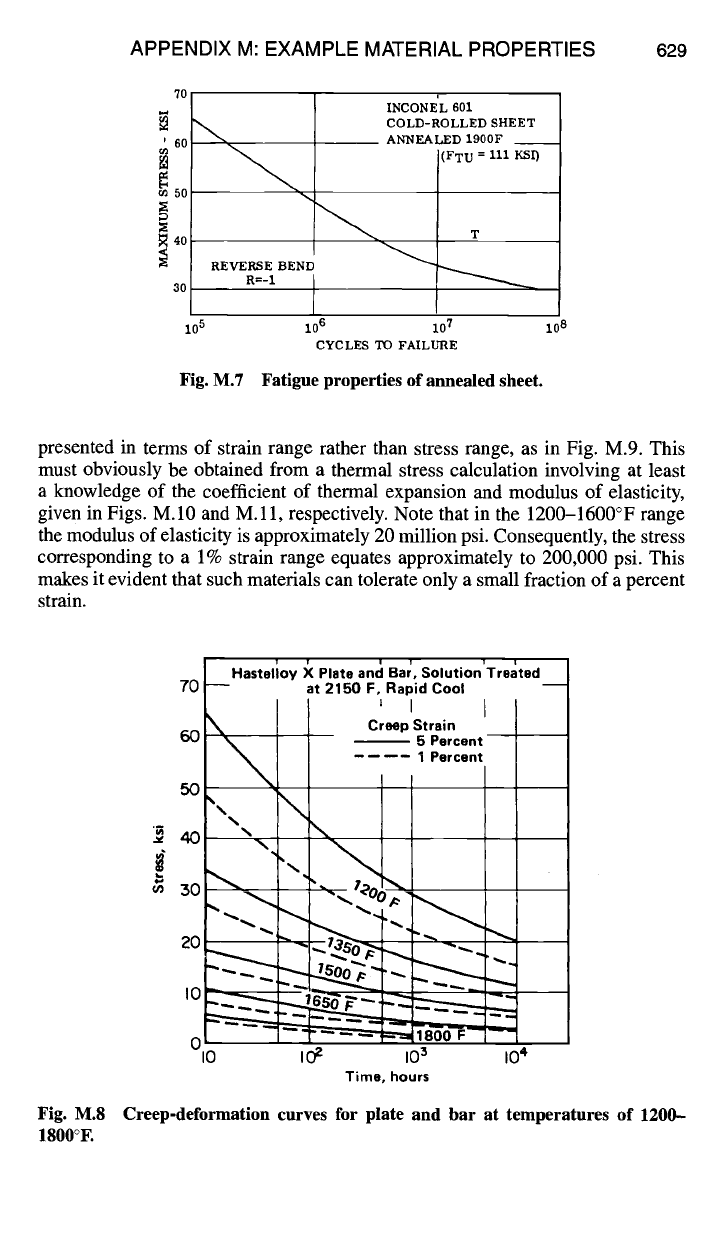
APPENDIX M: EXAMPLE MATERIAL PROPERTIES 629
70
' 60
m 50
30
\
REVERSE BEND
R=-I
INCONE'L 601
COLD-ROLLED
SHEET
ANNEALED
1900F
(FTU
=
ni
KSB
105 106 107
CYCLES TO FAILURE
Fig. M.7
108
Fatigue properties of annealed sheet.
presented in terms of strain range rather than stress range, as in Fig. M.9. This
must obviously be obtained from a thermal stress calculation involving at least
a knowledge of the coefficient of thermal expansion and modulus of elasticity,
given in Figs. M.10 and M.11, respectively. Note that in the 1200-1600°F range
the modulus of elasticity is approximately 20 million psi. Consequently, the stress
corresponding to a 1% strain range equates approximately to 200,000 psi. This
makes it evident that such materials can tolerate only a small fraction of a percent
strain.
7O
5O
40 "\
0
I0
Hastelloy )< Plate an¢t Bar, Solution'Treated
at 2150 F, Rapid Cool
' I
I
Creep Strain
5 Percent
....
I Percent
\
I0 2 10 3 10 4.
Time,
hours
Fig. M.8 Creep-deformation curves for plate and bar at temperatures of 1200--
1800°F.
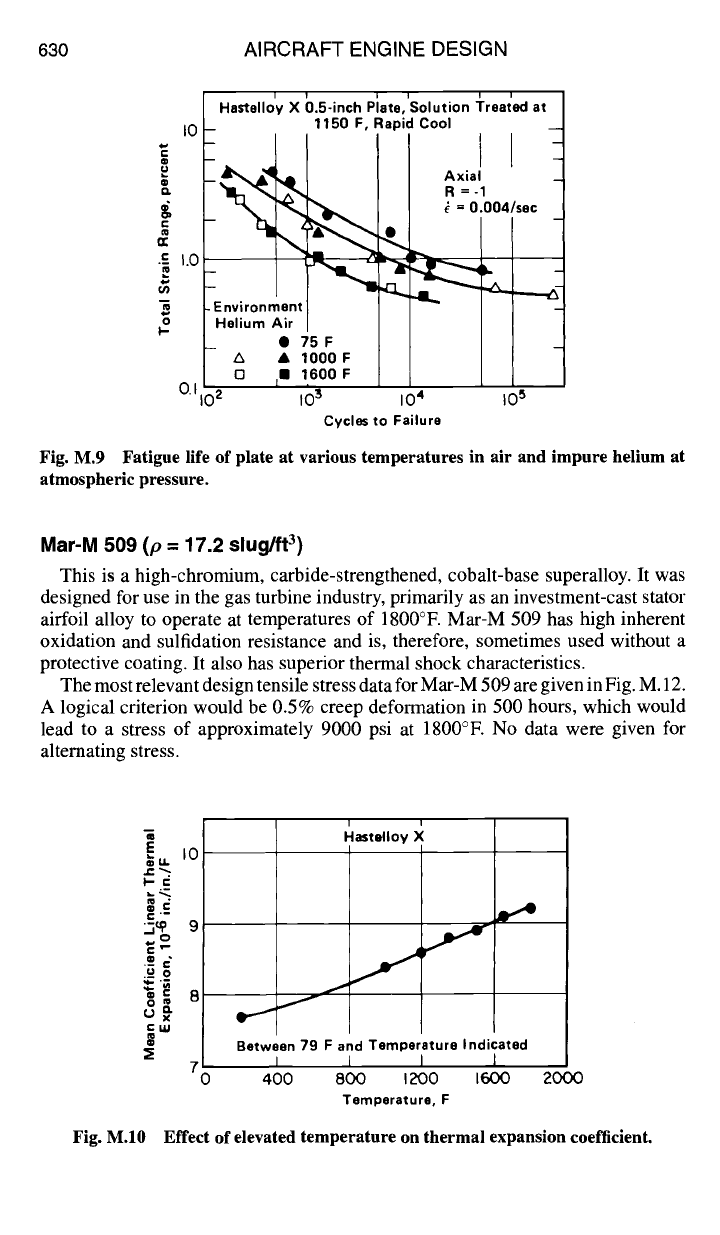
630 AIRCRAFT ENGINE DESIGN
I0
11.0
0
I-
-
Environment'
Helium Air
•
75F
A
•
1000 F
[3 Ill 1600 F
0"1102 10 3
i i i i i i
Ha~telloy X 0.5-inch Plate,
Solution Treated at
1150 F, Rapid Cool
2
10 4 10 5
Cycles to Failure
Fig. M.9 Fatigue life of plate at various temperatures in air and impure helium at
atmospheric pressure.
Mar-M 509 (p = 17.2 slug/ft 3)
This is a high-chromium, carbide-strengthened, cobalt-base superalloy. It was
designed for use in the gas turbine industry, primarily as an investment-cast stator
airfoil alloy to operate at temperatures of 1800°F. Mar-M 509 has high inherent
oxidation and sulfidation resistance and is, therefore, sometimes used without a
protective coating. It also has superior thermal shock characteristics.
The most relevant design tensile stress data for Mar-M 509 are given in Fig. M. 12.
A logical criterion would be 0.5% creep deformation in 500 hours, which would
lead to a stress of approximately 9000 psi at 1800°F. No data were given for
alternating stress.
¢=
E
~,, I0
'7~ 9
CW
i i
Hastalloy
X
Between
79 F
and Temperature
Indicated
I I I 1
400 800 1200 1600
Temperature, F
0 2000
Fig. M.10 Effect of elevated temperature on thermal expansion coefficient.
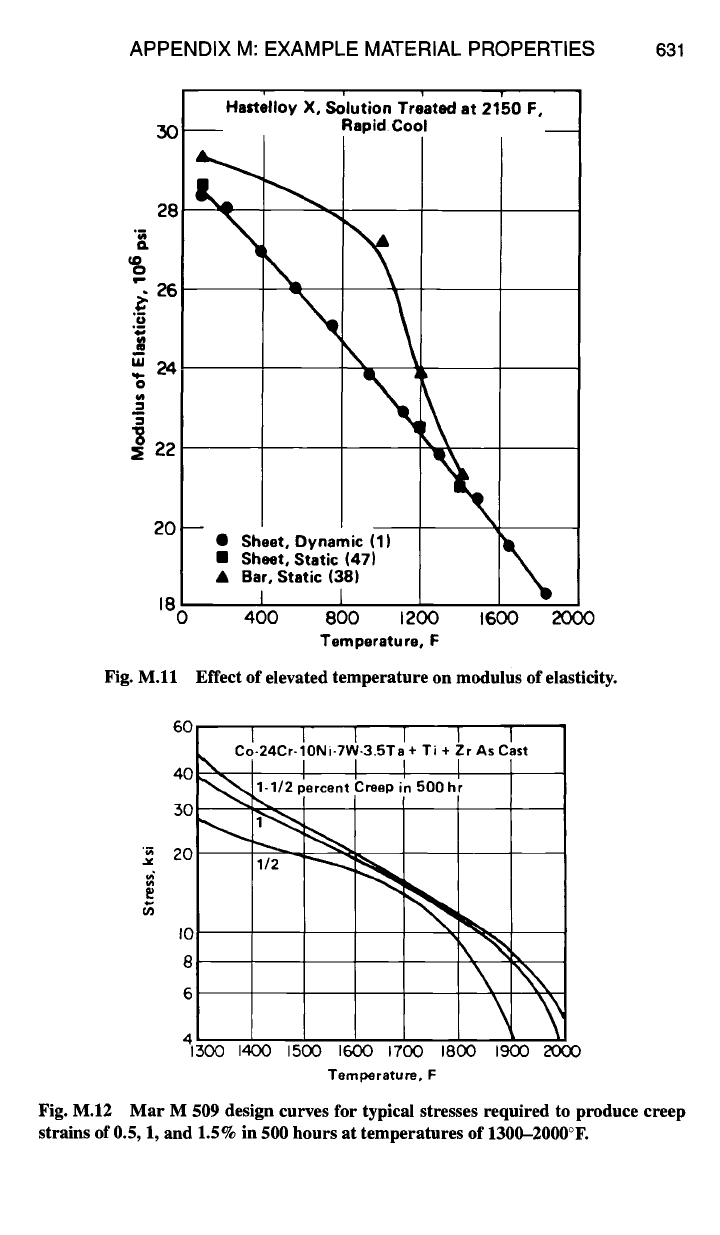
APPENDIX M: EXAMPLE MATERIAL PROPERTIES 631
Haltelloy
X,
Solution
Treated at
2150
F,
30 -- Rapid Cool
i
-,,
IE
22
2O
• Sheet, Dynamic Ill lib
• Sheet, Static (47)
\
• Bar, Static (38)
I L
1
80 400 800 1200
Temperature, F
Fig. M.11
1600 2000
Effect of elevated temperature on modulus of elasticity.
6O t [ l l t I
Co-24Cr-10Ni-7W-3.5Ta + Ti + Zr As Cast
4c \ I I I I I I
~ 1-1/2 percent Creep in 500 hr
4300
1400 1500 1600 1700 1800 1900 2000
Temperature, F
Fig. M.12 Mar M 509 design curves for typical stresses required to produce creep
strains of 0.5, 1, and 1.5% in 500 hours at temperatures of 1300-2000°F.
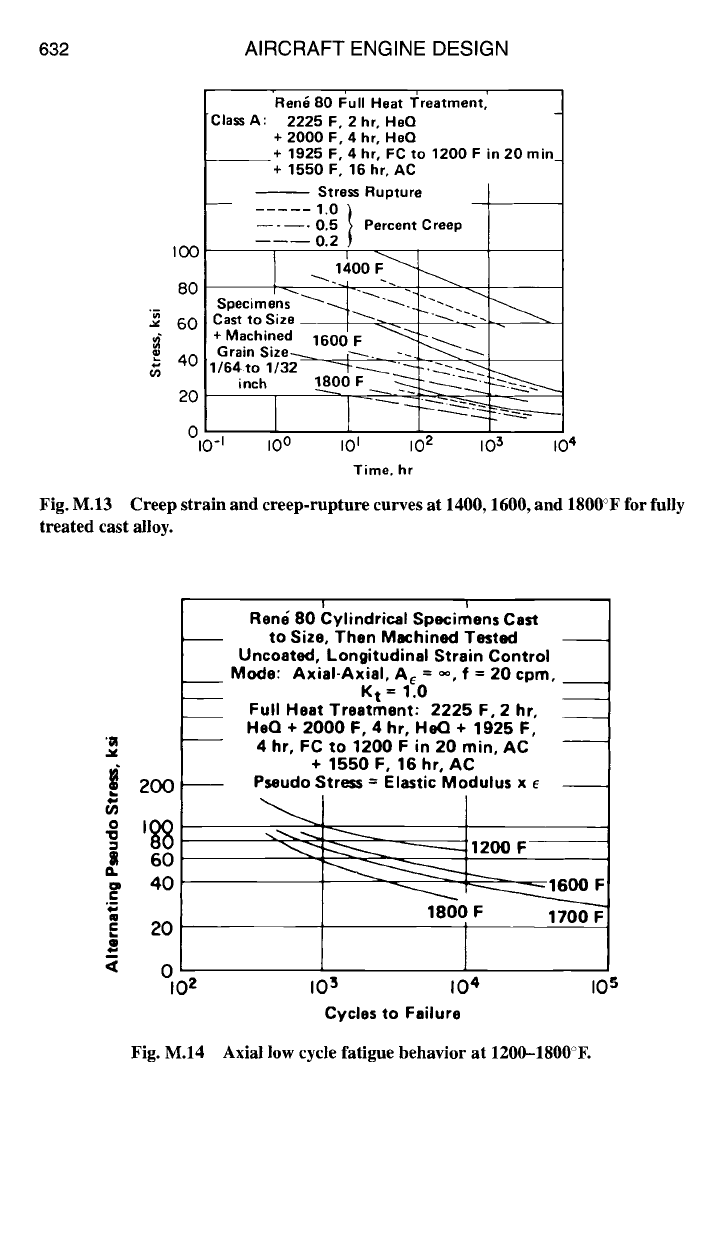
632 AIRCRAFT ENGINE DESIGN
I00
80
60
40
Ren~
80 F~ull Heat
"l:reatment'
"Class A: 2225 F, 2 hr, HeQ
+ 2000 F, 4 hr, HeQ
+ 1925
F, 4
hr, FC to 1200
F in 20 min_
+
1550 F, 16 hr, AC
--
Stress Rupture
..... 1.0 I
.... 0.5 Percent Creep
------0.2
Specimens ~--~ "'~.
"'-
Cast
to Size ~.
"-'~."''- "''''--
+ Machined 1600 F
Grain Size---__
l~"~. -..] ~"~ ~'-
1/64 to 1/32
inch 18800 F ~" "-~":" ~
20
) ~--~_ ~. -~.~
010-1 i0 0 I01 102 IO s 104
Time. hr
Fig. M.13 Creep strain and creep-rupture curves at 1400, 1600, and 1800°F for fully
treated cast alloy.
'a
0
"10
8
L
C
u
E
<
200 m
60
40
2O
0
I0 z
Fig. M.14
! I
Ren6 80
Cylindrical Specimens Cast
to Size, Then Machined Tested
Uncoated, Longitudinal Strain Control
__
Mode: Axial-Axial, A~ = 0% f = 20 cpm, __
K t = 1.0
Full Heat Treatment: 2225 F, 2 hr,
HeQ + 2000 F, 4 hr, HeQ + 1925 F,
4 hr, FC to 1200 F in 20 min, AC
+ 1550 F, 16 hr, AC
Pseudo Stress = Elastic Modulus x c
~--..~- 1200
F
1800 F 1700
F
10 3 10 4 IO s
Cycles to Failure
Axial low cycle fatigue behavior at 1200-1800°F.
